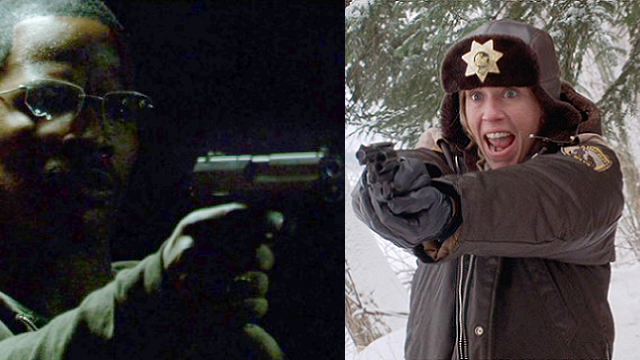I need to get an obvious thought out of the way first. Technically speaking, films are made up of four elements: script, images, sounds, and the time in which those images and sounds are displayed. That element of time is what makes films suited so well for drama – a film crew can overpower the viewer with consequence after consequence, putting them in the same headspace as the characters – and traditionally so poorly suited towards literature, as you almost always have either no time to fully contemplate a moment or way too much time to the point of boredom. But the presence of imagery adds an interesting wrinkle to this idea, allowing a savvy filmmaker to add literary depth to an otherwise completely dramatic script.
These two films are a perfect case study of this idea. Fargo, directed by the Coen brothers, is about Jerry Lundegaard (William H. Macy), a car salesman who hires two hitmen to kidnap his wife, and Marge Gunderson (Frances McDormand), the police chief who investigates the crime. Collateral, directed by Michael Mann, is about Max (Jamie Foxx), a taxi driver who picks up a hitman named Vincent (Tom Cruise) and is forced to drive him to the five targets he intends to kill that night. These are two downright archetypical crime plots, executed with all the elegance and dramatic power of their forebearers in the genre.
What makes them special – not necessarily better, but special – is that each takes advantage of the visual nature of film to bury the viewer in details. On the commentary, in explaining his process, Mann uses the phrase “the accumulation of detail” (this is, in fact, what inspired my definition of literature in the first place) to explain it – you’re fed a mass of details, and you put these details together in your head to create an idea of a person. As Mann goes on to explain, the nature of film means you’re probably not actually consciously aware of this process and might not even be able to articulate it – you don’t register that, say, an actor is wearing a costume, because you expect actors to wear costumes.
Therein lies the difference between the two films’ approaches. Collateral‘s details are logical, from either a genre or naturalistic perspective. It’s logical that a hitman in a crime thriller would wear a suit; the most offbeat choice is that it comes from Hong Kong rather than Europe or America. Even more specifically, Vincent almost exclusively kills people using what’s known as a Mozambique Drill (i.e. two shots to the chest, one to the head). We consciously register this as totally fucking badass; we might register it as proof this man was trained in killing people, even if we don’t know what a Mozambique Drill is; we almost certainly don’t register it as a character beat, the actions of a man who only does things that have a 100% certainty of success. But we do feel that detail, and when that attitude gets Vincent killed, it’s both shocking and logical.
Conversely, Fargo is almost exclusively built out of offbeat details. While it never gets outside the realm of plausible behaviour, it breaks unspoken aesthetic rules of the genre left and right. Criminals who hire hitmen are not car salesmen. Detectives are not pregnant women. Hitmen do not watch soap operas in their pyjamas. And sure as shit, nobody says “You betcha”. These shocking details in an otherwise structurally perfect crime drama are as satisfying a break in pattern as, say, the creation of SCDP in Mad Men.
What the movies share is an underlying feeling. Pure drama is highly emotional and very small – The Shield is an apocalypse that affects maybe a dozen people. Pure literature is monotonous and huge – nothing happens over the course of a decade in Mad Men, but it happens to all of America. These two movies accomplish a sense of density – the weight of literary details focused on the sharp point of drama.

